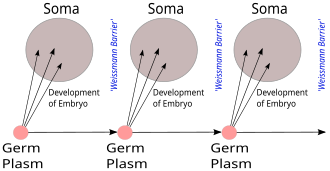Weismann barrier

The Weismann barrier, proposed by
somatic cells (that is, somatic mutations are not inherited).[3] This does not refer to the central dogma of molecular biology, which states that no sequential information can travel from protein to DNA or RNA, but both hypotheses relate to a gene-centric view of life.[4]
Weismann set out the concept in his 1892 book Das Keimplasma: eine Theorie der Vererbung (The Germ Plasm: a theory of inheritance).[5]
The Weismann barrier was of great importance in its day and among other influences it effectively banished certain
evolution of death
of the somatic line.
Plants and basal animals
In plants, genetic changes in somatic lines can and do result in genetic changes in the germ lines, because the germ cells are produced by somatic cell lineages (vegetative
Porifera) and corals (Anthozoa) contain multipotent stem cell lineages, that give rise to both somatic and reproductive cells. The Weismann barrier appears to be of a more recent evolutionary origin among animals.[11]
Immortality of the germ line
The Russian biologist and historian
germ lines. Rather Medvedev thought that known features of the biochemistry and genetics of sexual reproduction indicated the presence of unique information maintenance and restoration processes at the different stages of gametogenesis. In particular, Medvedev considered that the most important opportunities for information maintenance of germ cells are created by recombination during meiosis and DNA repair; he saw these as processes within the germ cells that were capable of restoring the integrity of DNA and chromosomes from the types of damage that caused irreversible ageing in somatic cells.[12]
See also
- Alternatives to evolution by natural selection– List of alternatives to Darwinian natural selection
- Baldwin effect – Effect of learned behavior on evolution
- Transgenerational epigenetic inheritance – Epigenetic transmission without DNA primary structure alteration
- Lamarckism – Scientific hypothesis about inheritance
- Pangenesis – Darwin's proposed mechanism for heredity
References
- PMID 4908353.
- ^ You, Yawen (26 January 2015). "The Germ-Plasm: a Theory of Heredity (1893), by August Weismann". The Embryo Project Encyclopedia (Arizona State University). Retrieved 7 September 2018.
- JSTOR 4608123.
- S2CID 85866639.
- ^ Weismann, August (1892). Das Keimplasma: eine Theorie der Vererbung. Jena: Fischer.
- OL 23380098M.
- ^ Lindley, Robyn A. "How Mutational and Epigenetic Changes Enable Adaptive Evolution". G. I. T. Laboratory Journal.
- OL 23380098M.
- ^ Ridley, Mark (2004). Evolution (3rd ed.). Blackwell. pp. 295–297.
- S2CID 20411802.
- PMID 27997535.
- S2CID 35719466.
